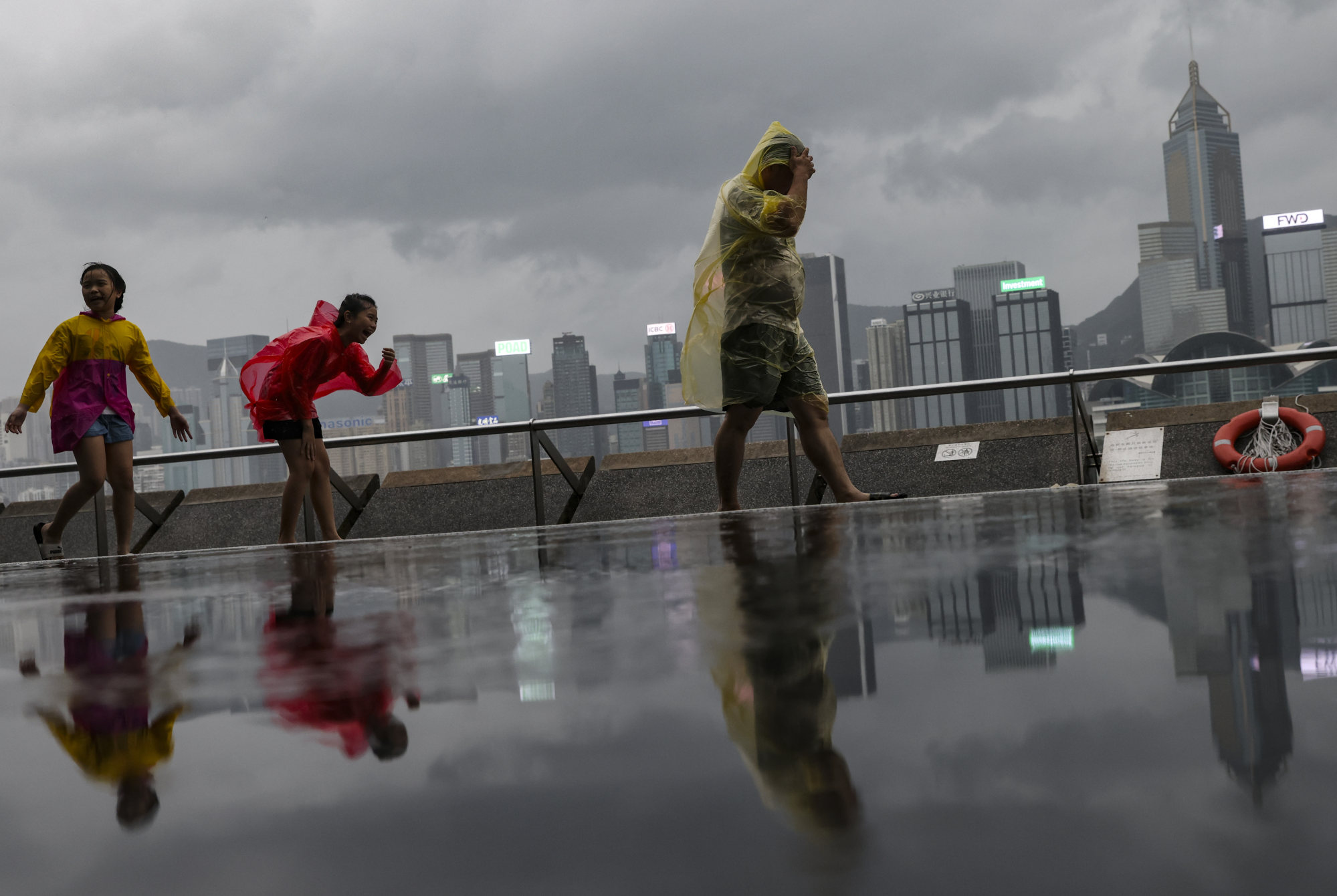[ad_1]
Hong Kong is bracing for its second typhoon in less than a week, as experts estimate billions of dollars in economic losses from the storm that pummelled the city over the weekend.
The Observatory on Sunday said it would issue a No 1 typhoon warning on Monday, as Typhoon Haikui headed towards the city and the eastern coast of Guangdong province from southern Taiwan.
The start of the new school year for Hong Kong pupils was delayed to Monday as a result of Super Typhoon Saola, the most powerful storm to hit in five years, which paralysed the city as it swept through on Friday and Saturday.
Hong Kong experts say Saola’s ‘double eyewall’ typical of very strong storms
Hong Kong experts say Saola’s ‘double eyewall’ typical of very strong storms
Economists said the two-day disruption caused by Saola cost Hong Kong between HK$3.3 billion and HK$12 billion (US$1.53 billion) in lost business, while the catering sector warned of a “further blow” if another storm forced closures.
“If we’re talking about consumption activities, then losing a day or two is not great, especially when the economic recovery is still not very solid,” said Gary Ng Cheuk-yan, senior economist at Natixis Corporate and Investment Bank.
He warned that economic growth would suffer if the city was brought to a standstill from another typhoon.
On Monday, Haikui is expected to move across the southern part of Taiwan and towards the eastern coast of Guangdong to southern Fujian.

“But Haikui’s movement remains uncertain,” the Observatory said.
Haikui had a maximum wind speed of 165km/h (102mph) on Sunday and it would enter the Taiwan Strait on Monday, the forecaster said. In comparison, Saola clocked wind speeds of more than 200km/h when it struck Hong Kong on Friday.
Hong Kong is still recovering from Saola, which left fallen trees, rubbish-strewn streets and flooded coastal communities in its wake. Seven beaches, such as those in Sai Kung and Tai Po, remained closed pending clearance of piles of rubbish or repair of facilities.
The Observatory said weather on Monday would be very hot due to the influence of the outer subsiding air of Haikui. Temperatures are expected to hit 34 degrees Celsius (93.2 Fahrenheit) in urban areas and showers are predicted for the middle of the week, with offshore winds to pick up.
Haikui is the Chinese name for sea anemones, a flowerlike type of marine animal.
The Post looks back at Hong Kong’s deadliest typhoons as storm Saola draws near
The Post looks back at Hong Kong’s deadliest typhoons as storm Saola draws near
Saola, which had been downgraded from a super typhoon, would move towards the vicinity of Beibu Wan in western mainland China and continue to weaken on Monday, the forecaster said.
Senior economist Ng put the economic cost from Saola at HK$12 billion as a “worst case scenario”, based on 1½ days of the daily average value of gross domestic product (GDP) this year, using an estimated annual value of HK$2.9 trillion.
The government forecast the full-year GDP this year to grow between 4 and 5 per cent over 2022’s figures.
Ng said the shutdown landing on Friday, a work day, had affected economic activity as well as causing the stock market to cease trading. Closures on Saturday, meanwhile, hurt retail sales.
About 460 flights were cancelled because of the storm, hitting another vital part of the economy as the city looked to recover tourism numbers, Ng said.
Typhoon Saola leaves debris, fallen trees on Hong Kong roads, but impact small
Typhoon Saola leaves debris, fallen trees on Hong Kong roads, but impact small
Economist Simon Lee Siu-po, honorary fellow at Chinese University’s Asia-Pacific Institute of Business, estimated the economic loss at HK$6.6 billion for two days based on the average daily transactions in retail, catering and services provided by companies as part of GDP.
Associate professor of economics Terence Chong Tai-leung, also of Chinese University, was more conservative. He placed losses at about HK$3.3 billion, based on the average value of GDP generated over about a third of a day, taking reference from last year’s overall GDP of about HK$3.3 trillion.
“During the typhoon we still had some people working. There was still some economic activity going on,” Chong said.
“Some trading would be carried out the next day after markets open. So Monday [would expect] to have more volume. But, of course, restaurants are closed and people won’t eat double the amount of food the day after the typhoon,” he said, referring to the stock market.
Are Hong Kong’s typhoons getting stronger? Forecaster points to new patterns
Are Hong Kong’s typhoons getting stronger? Forecaster points to new patterns
Simon Wong Ka-wo, president of the Hong Kong Federation of Restaurants and Related Trades, estimated that the food and beverage sector, with about 17,000 restaurants, had lost HK$400 million in business over the two days. He said that was down 80 per cent from typical takings generated during the same period.
With a storm on the horizon, although its path was not yet clear, a further citywide shutdown would be “another blow for us”, he said.
“The outlook is not quite promising at this moment. Many small and medium-sized enterprises are struggling for survival. People have lessened their spending. Hongkongers have travelled to Shenzhen and Greater Bay Area cities during weekends, and tourist [numbers] from mainland and overseas haven’t recovered, which is another challenge for us.”
The Airport Authority, which operates city’s airport, told the Post it expected to handle 850 flights on Sunday. A check by the Post found a flight to Kaohsiung in Taiwan, operated by Cathay Pacific, was cancelled in the evening as Typhoon Haikui made landfall on the island.
[ad_2]
Source link
